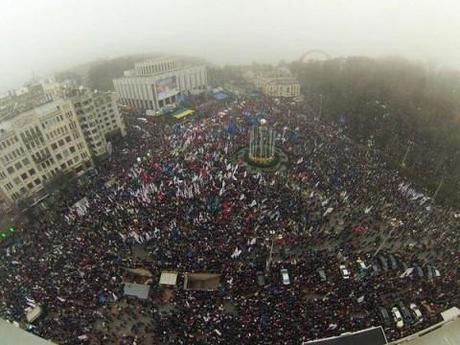
On Sunday morning, CIPE Program Manager Zoia Tsybrova braved the cool, rainy weather to observe the EuroMaidan protests forming in the center of Kyiv. The Shevchenko building, where the rally was intended to be held, could not hold all the participants, and it did not take long for people to start walking, meeting friends and family, filling the streets of Kyiv. The mood, says Tsybrova, was euphoric. Not only on Sunday but today as well. Three days later, the people are still there, with a mass of students demonstrating still; the good mood remains, with people handing out hot tea and sandwiches to those on the streets. People are still dressed up for the occasion, smiling, walking with Ukrainian and European symbols, with homemade cards, signs, banners, and flags.
What was the impetus of this? The protesters were pushed over the edge by the government’s decision to suspend the pursuit of an association agreement with the European Union (EU). The association agreement could have been signed in Vilnius, Lithuania at the EU Partnership Summit on November 28-29. It is a political and free trade deal that has been on the international community’s radar for a number of months as it offered the possibility to Ukraine to begin integration into the European Union.
The deal’s suspension caused a response that was both unexpected and a turnout that was noteworthy, to say the least. Early estimates have put the number of protesters rallying on Sunday at 100,000. Ukraine has not seen a protest this large since the Orange Revolution in the winter months of 2004 leading into 2005. Following the government’s decision to suspend the pursuit of this agreement with the European Union on November 21, the people have come together in mass rallies again on Kyiv’s Independence Square (Maidan Nezalezhnosti). Over the weekend, protests sprung in other cities around Ukraine, too, from east to west.
In the weeks leading up to the EU Partnership Summit, Ukraine has faced pressure from Russia not to sign the association agreement, as Russian President Vladimir Putin has pushed for Kyiv to join the Moscow-led Customs Union with Belarus and Kazakhstan instead. Meanwhile, the European Union has urged the Ukrainian government to release ex-Prime Minister Yulia Tymoshenko, who was a leader of Ukraine’s 2004 Orange Revolution. It has been nine years since the Orange Revolution, and in many ways Ukraine has found itself peering back in time. In 2004, the Ukrainian presidential election was widely believed to be marred by massive corruption, voter intimidation, and even direct electoral fraud. People took to the streets, baring orange on their clothes and flags, in support of the opposition party, Our Ukraine (Nasha Ukraina). Upwards of 500,000 protesters demonstrated daily nationwide. What came to be known as the Orange Revolution sought to pull Ukraine from cronyism and toward the west. The people rallied and were successful – a re-vote was ordered by Ukraine’s Supreme Court in December 2004. The second run-off was declared to be free and fair.
Today’s and 2004 protests are an easy comparison to make but the key difference is a bold one – and a sign of Ukraine’s maturation. Nine years ago, Tsybrova wrote, Ukrainians went out to the streets to declare their right to self-determination under the orange banners, in support of the opposition party leaders. And though EuroMaidan appears similar to the Orange Revolution, it is another Maidan altogether. What makes this protest unique from the Orange Revolution is that although opposition leaders were present, they did not take hold. Milan Kundera, a Czech writer and dissident, wrote in Identity: “Remembering our past, carrying it with us always, may be the necessary requirement for maintaining, as they say, the wholeness of the self.” In 2013, the people are not rallying under colors, political slogans, or personality figures; they are rallying in off-white tents, under the Ukrainian flag, and waving that of the EU. They have come together, whole, as a nation, standing for their rights as citizens, for their well-being, under no banners but general human values.
These protests are grassroots, led by the civil society that may be disillusioned and probably cynical but clearly ready and willing to stand in the cold and the rain to protest the trajectory of their country, not just the move to postpone the political and free trade deal. EuroMaidan erupted on Sunday following the governmental decision to delay the EU agreement but it was about much more than that. EuroMaidan is a reaction to an ongoing heap of civil abuses. Prior to delaying the agreement, the Ukrainian parliament – with the majority of its members being Yanukovych supporters – rejected six draft laws to release Tymoshenko.
Now, with the European integration so close – and so far – people’s frustration found expression on the streets. And though the euphoria felt on the streets on Kyiv and nationwide is similar in many ways to the feelings of the Orange Revolution, the drive is one that is independently strong, and locally motivated. Ultimately, this new drive may open up doors for Ukrainian society with the European Union and in that sense EuroMaidan is a great leap forward for Ukraine, not a repetition of the past.
- Continuous coverage in the Kyiv Post
- Live video streaming of the protests here on Radio Svoboda (Radio Liberty)
- Follow on Twitter using hashtags #euromaidan and #євромайдан.
Rachel Grossman is Program Assistant for Eurasia at CIPE.

